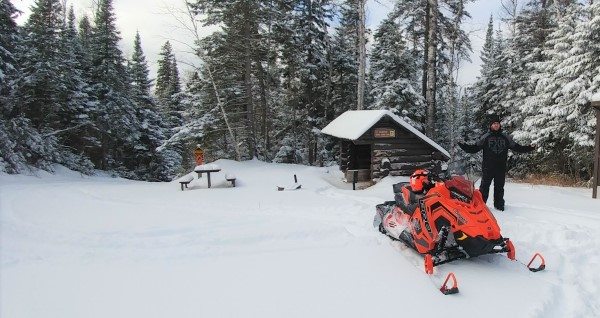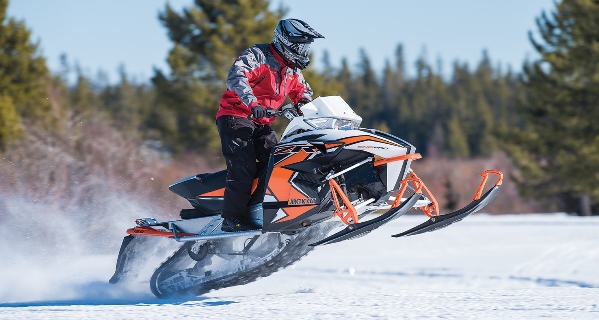
We made another run toward snow last week, and this time it was to break in our Arctic Cat XF 1100 Turbo Sno Pro, Ski-Doo Renegade E-TEC 800R Backcountry X and Polaris 800 Rush Pro-R LE demo sleds. Here are some impressions of each snowmobile.
Arctic Cat XF 1100 Turbo Sno Pro
The Arctic Cat XF 1100 Turbo Sno Pro feels right when sitting still and when going down the trail. Handlebars and seat are tall and the driver has an upright posture. The machine feels pretty well planted and stable. Handling is better than our F 800 Sno Pro, with less corner push. Extra weight from the big four-stroke engine must help to keep pressure on the skis so they bite. Fortunately, steering effort is comfortable, too.
Ride quality is similar to that of the F 800 Sno Pro. The new Arctic Race Suspension (ARS) transmits very little feedback to the driver, but the rear end is too firm. Like we said last week about the 800 Sno Pro’s skidframe, the rear suspension feels harsh mid-stroke. Compression early in the suspension travel is fine, but it suddenly becomes firm part-way into the stroke. We look forward to more saddle time this season so we can adjust the air pressure setting in the XF 1100 Turbo Sno Pro’s Fox FLOAT rear shock.
Power from the 1100 Turbo engine is amazing. The sled accelerates so quickly and pulls so hard that it’s mind-boggling. Cruising 70 mph along a railroad grade puts the throttle lever at about a quarter of the way, and a quick blip of the lever from, say, 70 mph, will cause the sled to pick up another 20 mph in the blink of an eye. Over the course of our 250-mile ride we tightened the track three times because it ratcheted on acceleration. If you own a new turbo-powered Cat, bring a good wrench and ratchet so you can adjust the track with better tools than what comes from the Cat factory.
Ski-Doo Renegade E-TEC 800R Backcountry X
With the Backcountry X having a narrow ski stance, we assumed it might be a little tippy through turns, but the sled cornered surprisingly flat. The Pilot DS (Deep Snow) skis suffered more corner push than we expected, though. We’ll run the sled with the stock skis for at least one more ride, but we might go to the aftermarket to find some skis with more bite.
We’ve run almost three tanks of fuel through the E-TEC 800 engine, and performance has been good. There’s a strong pull all the way through and the engine and exhaust run quietly and precisely. Two friends who rode with me Thursday and Friday reported some stumbling from the engine. I never felt the condition from this Renegade, but symptoms they described sound similar to what I experienced last week with our MX Z E-TEC 600. Frankly, we’re not concerned about it with either sled, and Ski-Doo says that this condition is completely normal and it will subside after the engine is fully broken in.
The ski shocks were too firm for roughly 12-inch chop we encountered, but turning the clickers from the original setting of 11 clicks from full soft to seven clicks from full soft significantly improved the ride quality.
We opted for the Camoplast Challenger track when ordering our Backcountry X. This 2-day ride was our most experience with a Challenger track and indications are that it’s a good shoe for this class of sled. The rear end of the snowmobile held stable through turns without washing out, and with the 1.5-inch lugs it hooked up well for straight line acceleration. Hopefully we’ll find some deep snow to play in later this season in so we can evaluate its performance there.
Polaris 800 Rush Pro-R LE
A lot of the trails where we rode – the Lake Gogebic region of Michigan – were chopped up. The area received about a foot of snow early last week, and heavy snowmobile traffic since then has made it difficult for the groomer operators to keep up, but these were ideal conditions for a Rush with the Pro-Ride suspension.
The sled feels big and stable over stutter bumps and “protects” the driver from the big bumps and chop. The machine feels relatively tight up front with a springier feeling from the rear suspension. Its stability made us confident to power through the rough trails. Ski shocks were set three clicks from full soft, front track shock was two clicks from full soft and the rear shock was four clicks from full soft. Riders were 155 pounds, 210 pounds and 215 pounds. We adjusted the rear spring for each rider, but did not change shock clicker settings.
Compared to earlier Rush models, the 2012 model is a nice improvement in terms of handling. We had an 800 Rush Pro-R last season as a demo and fought its inside ski lift, but our 2012 demo corners flatter and pitches less through rough turns. The 2012 Polaris Rush has reconfigured suspension geometry that gives a much calmer, more relaxed riding experience. We’re excited to spend more time on our Rush demos — we also have a 600 Rush — and MX Z 600 with the rMotion skidframe to see how the production suspensions compare.
The 800 Liberty engine in our 800 Rush Pro-R LE offered no surprises. It was its typical self with good low-end punch and a brawny exhaust note. It must’ve loosened up around the 100-mile mark as it started to pull harder and make the sled accelerate quicker out of corners.
Unfortunately I don’t have any photos of these sleds on the trail. The camera broke and, unlike the three sleds we rode, needs to go to a shop for repairs. I’m hoping to do a backpack run next weekend, again in the Upper Peninsula of Michigan. The Lake Gogebic area could use another blast of snow, but if you’re looking to ride, you’ll have fun there and be able to put on miles, just don’t expect premo conditions.
— Andy Swanson Snow Goer Managing Editor


